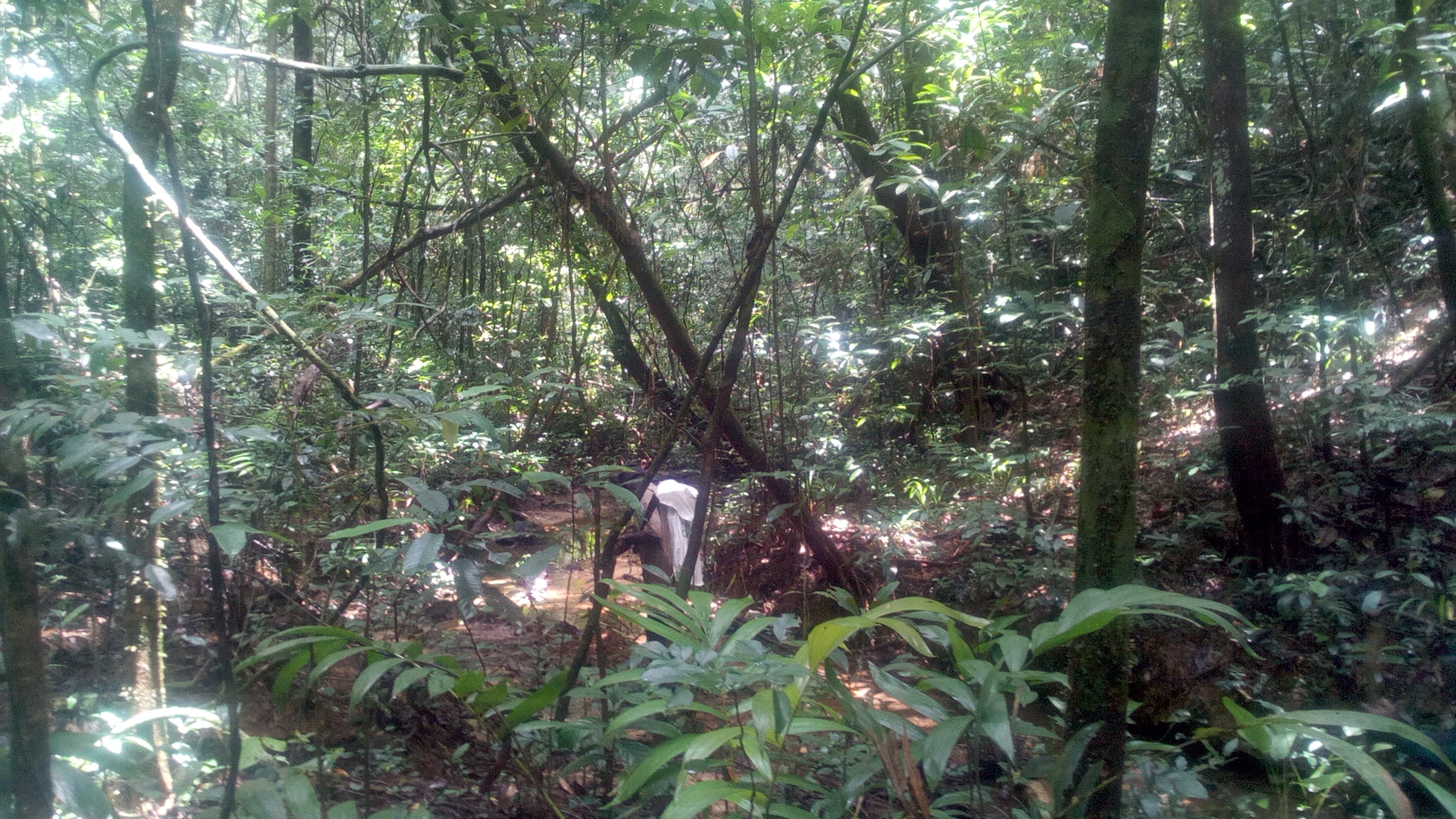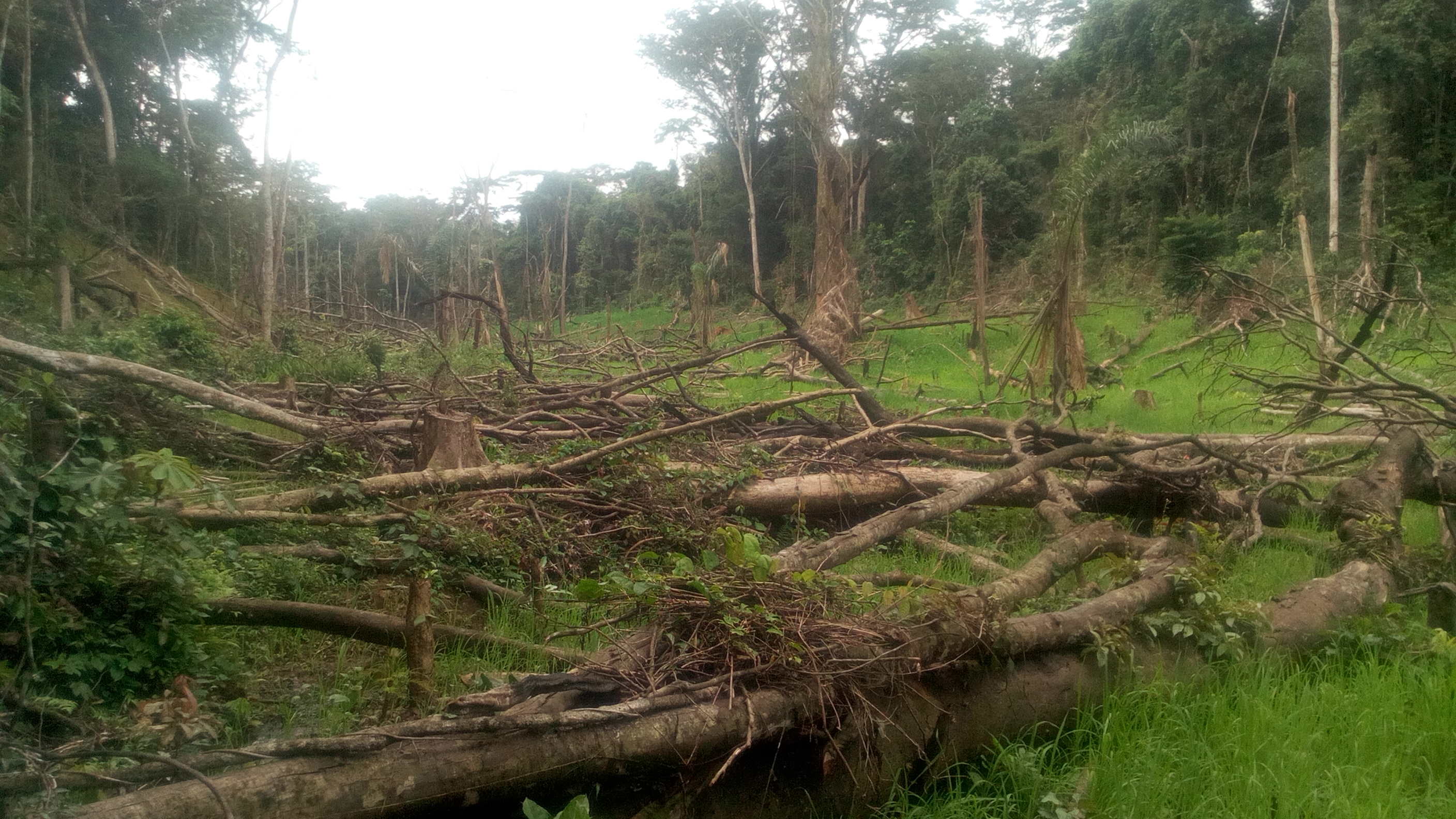
Country: Guinea
Administrative region: Yomou (Prefecture)
Central co-ordinates: 7.21000 N, 8.94528 W
Area: 640km²
Qualifying IPA Criteria
A(i)Site contains one or more globally threatened species, B(i)Site contains a high number of species within defined habitat or vegetation types, C(iii)Site contains nationally threatened or restricted habitat or vegetation types, AND/OR habitats that have severely declined in extent nationally
IPA assessment rationale
Dièké Classified Forest is the largest intact area of lowland forest remaining in Guinée
Forestière and potentially Guinea as a whole. It has a high diversity of species including 29 threatened species especially timber trees. Many West African trees have their only Guinean location in this forest. Dièké remains to be comprehensively surveyed for its plant species.
Site description
Lowland evergreen forest situated in the south east of Guinée Forestière in Yomou prefecture, close to the border of Liberia. This has been a Classified Forest since 1945. It was previously logged in certain areas leaving an open canopy, but most of the site is still relatively intact forest with an open understory. The forest is bordered by villages and cultivation has encroached on some of the boundaries.


Botanical significance
Dièké is the largest surviving near pristine lowland evergreen forest area in Guinée Forestière. It has many rivers running through it and has a high diversity of plant species including some threatened species e.g. Allophylus samouritourei (Haba, 2018). Large girth trees of timber species are still present forming a dense canopy (Haba, 2016 and 2018).
Habitat and geology
The area is gently undulating with hills reaching 550m, with forested slopes and riverine forest in the valleys. It sits on the late Archean period Mani series of biotite gneiss with localized magnetite. It is part of the Leonean-Liberian crystalline massif.
Conservation issues
Part of the classified forest of Dièké was exploited by the Forët Forte Company between 2003- 2004, but fortunately they did not do much damage in this brief period. However their activities are thought to have caused the presence of invasive species in the forest.
Areas in the river valleys (Bas-fonds) have been authorized for rice cultivation in recent years, which has led to the encroachment of fields from the surrounding area. The areas closest to Kéréma, Ouéta, Kilikpala, Nonah and Gboimou are especially threatened by encroachment of fields and by the illegal hunting of the neighboring population. In March 2022, areas were observed that had been cleared clandestinely for farming on the edge of the classified forest at Lowi and Saoro.
Towards the East, in the zone of Yonsono, Guêpa and Diécké, hunting dominates and so the forest has remained intact, though small areas are routinely cleared to make camps for the hunters. Eco-guards are present, but they do not regularly patrol the forest. Hunting and harvesting of non-timber forest products are increasing and need to be monitored to ensure sustainable practices are being used. Some species have been observed with bark stripped effectively ring-barking the tree which kill the tree.
Ecosystem services
Habitat for species, provisioning.
Site assessor(s)
Charlotte Couch, Royal Botanic Gardens Kew
Pépé Haba, Guinée Biodiversité
Faya Julien Simbiano, Herbier National de Guinee
IPA criterion A species
| Species | Qualifying sub-criterion | ≥ 1% of global population | ≥ 5% of national population | 1 of 5 best sites nationally | Entire global population | Socio-economically important | Abundance at site |
|---|---|---|---|---|---|---|---|
| Allophylus samoritourei Cheek | A(i) |  |
 |
 |
 |
 |
Scarce |
| Cola attiensis Aubrév. & Pellegr. | A(i) |  |
 |
 |
 |
 |
Unknown |
| Neolemonniera clitandrifolia A.Chev. | A(i) |  |
 |
 |
 |
 |
Scarce |
| Tieghemella heckelii (A.Chev.) Pierre ex Dubard | A(i) |  |
 |
 |
 |
 |
Scarce |
| Albizia ferruginea (Guill. & Perr.) Benth. | A(i) |  |
 |
 |
 |
 |
Scarce |
| Amanoa bracteosa Planch. | A(i) |  |
 |
 |
 |
 |
Unknown |
| Cryptosepalum tetraphyllum (Hook.f.) Benth. | A(i) |  |
 |
 |
 |
 |
Abundant |
| Drypetes afzelii (Pax) Hutch. | A(i) |  |
 |
 |
 |
 |
Scarce |
| Entandrophragma cylindricum (Sprague) Sprague | A(i) |  |
 |
 |
 |
 |
Scarce |
| Entandrophragma candollei Harms | A(i) |  |
 |
 |
 |
 |
Scarce |
| Entandrophragma utile (Dawe & Sprague) Sprague | A(i) |  |
 |
 |
 |
 |
Scarce |
| Garcinia afzelii Engl. | A(i) |  |
 |
 |
 |
 |
Scarce |
| Garcinia epunctata Stapf | A(i) |  |
 |
 |
 |
 |
Unknown |
| Leplaea cedrata (A.Chev.) E.J.M.Koenen & J.J.F.E.de Wilde | A(i) |  |
 |
 |
 |
 |
Scarce |
| Khaya anthotheca C.DC. | A(i) |  |
 |
 |
 |
 |
Scarce |
| Khaya ivorensis A.Chev. | A(i) |  |
 |
 |
 |
 |
Scarce |
| Khaya grandifoliola C.DC. | A(i) |  |
 |
 |
 |
 |
Scarce |
| Lophira alata Banks ex Gaertn.f. | A(i) |  |
 |
 |
 |
 |
Abundant |
| Nauclea diderrichii (De Wild. & T.Durand) Merrill | A(i) |  |
 |
 |
 |
 |
Abundant |
| Pericopsis elata (Harms) Meeuwen | A(i) |  |
 |
 |
 |
 |
Unknown |
| Terminalia ivorensis A.Chev. | A(i) |  |
 |
 |
 |
 |
Scarce |
| Cassia fikifiki Aubrev. & Pellegr. | A(i) |  |
 |
 |
 |
 |
Scarce |
| Copaifera salikounda Heckel | A(i) |  |
 |
 |
 |
 |
Scarce |
| Tessmannia baikieaoides Hutch. & Dalziel | A(i) |  |
 |
 |
 |
 |
Scarce |
| Anopyxis klaineana (Pierre) Engl. | A(i) |  |
 |
 |
 |
 |
Scarce |
| Garcinia kola Heckel | A(i) |  |
 |
 |
 |
 |
Scarce |
| Guibourtia leonensis J. L�onard | A(i) |  |
 |
 |
 |
 |
Scarce |
Allophylus samoritourei Cheek





Cola attiensis Aubrév. & Pellegr.





Neolemonniera clitandrifolia A.Chev.





Tieghemella heckelii (A.Chev.) Pierre ex Dubard





Albizia ferruginea (Guill. & Perr.) Benth.





Amanoa bracteosa Planch.





Cryptosepalum tetraphyllum (Hook.f.) Benth.





Drypetes afzelii (Pax) Hutch.





Entandrophragma cylindricum (Sprague) Sprague





Entandrophragma candollei Harms





Entandrophragma utile (Dawe & Sprague) Sprague





Garcinia afzelii Engl.





Garcinia epunctata Stapf





Leplaea cedrata (A.Chev.) E.J.M.Koenen & J.J.F.E.de Wilde





Khaya anthotheca C.DC.





Khaya ivorensis A.Chev.





Khaya grandifoliola C.DC.





Lophira alata Banks ex Gaertn.f.





Nauclea diderrichii (De Wild. & T.Durand) Merrill





Pericopsis elata (Harms) Meeuwen





Terminalia ivorensis A.Chev.





Cassia fikifiki Aubrev. & Pellegr.





Copaifera salikounda Heckel





Tessmannia baikieaoides Hutch. & Dalziel





Anopyxis klaineana (Pierre) Engl.





Garcinia kola Heckel





Guibourtia leonensis J. L�onard





IPA criterion C qualifying habitats
| Habitat | Qualifying sub-criterion | ≥ 5% of national resource | ≥ 10% of national resource | 1 of 5 best sites nationally | Areal coverage at site |
|---|---|---|---|---|---|
| West African Lowland Evergreen Forest | C(iii) |  |
 |
 |
600 |
West African Lowland Evergreen Forest


General site habitats
| General site habitat | Percent coverage | Importance |
|---|---|---|
| Forest - Subtropical/Tropical Moist Lowland Forest |  |
Major |
Forest - Subtropical/Tropical Moist Lowland Forest

Land use types
| Land use type | Percent coverage | Importance |
|---|---|---|
| Nature conservation |  |
Unknown |
| Forestry |  |
Unknown |
| Agriculture (arable) |  |
Minor |
Nature conservation

Forestry

Agriculture (arable)

Threats
| Threat | Severity | Timing |
|---|---|---|
| Agriculture & aquaculture - Annual & perennial non-timber crops - Shifting agriculture | Medium | Ongoing - increasing |
| Biological resource use - Logging & wood harvesting | Low | Past, not likely to return |
| Biological resource use - Logging & wood harvesting - Intentional use: subsistence/small scale (species being assessed is the target) [harvest] | Medium | Ongoing - increasing |
| Biological resource use - Gathering terrestrial plants - Intentional use (species being assessed is the target) | Low | Ongoing - trend unknown |
Agriculture & aquaculture - Annual & perennial non-timber crops - Shifting agriculture
Biological resource use - Logging & wood harvesting
Biological resource use - Logging & wood harvesting - Intentional use: subsistence/small scale (species being assessed is the target) [harvest]
Biological resource use - Gathering terrestrial plants - Intentional use (species being assessed is the target)
Protected areas
| Protected area name | Protected area type | Relationship with IPA | Areal overlap |
|---|---|---|---|
| Diéké Classified Forest | Classified Forest | protected/conservation area matches IPA |  |
Diéké Classified Forest

Management type
| Management type | Description | Year started | Year finished |
|---|---|---|---|
| No management plan in place |  |
 |
No management plan in place


Bibliography
Flore (Angiospermes) de la République de Guinée.
Threatened plants species of Guinea-Conakry: A preliminary checklist
Peerj Preprints
IUCN Red List
Important Bird Areas factsheet: Diecke
Mission d’Inventaire des Espèces de la Liste Rouge de Guinée dans la Forêt Classée de Diécké au village Nonah.
Rapport de terrain du projet Darwin Initiative en Guinée : Forêt Classée de Diécké : Villages-Guêpa-Yonsono
Recommended citation
Charlotte Couch, Pépé Haba, Faya Julien Simbiano (2024) Tropical Important Plant Areas Explorer: Diéké Classified Forest (Guinea). https://tipas.kew.org/site/dieke-classified-forest/ (Accessed on 27/07/2024)


